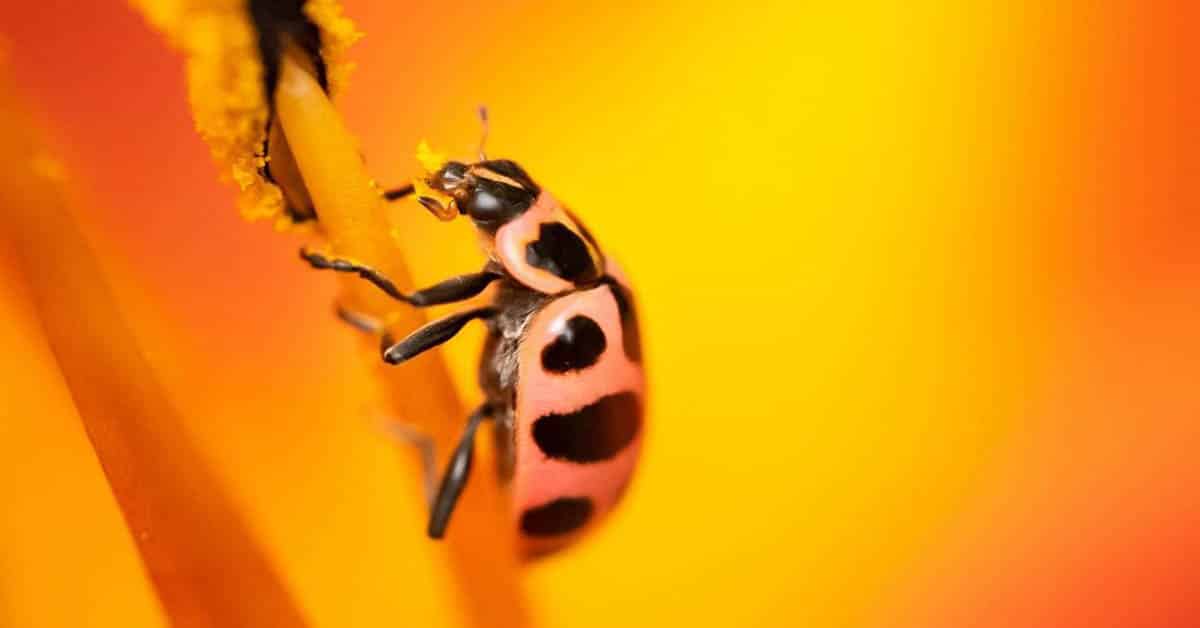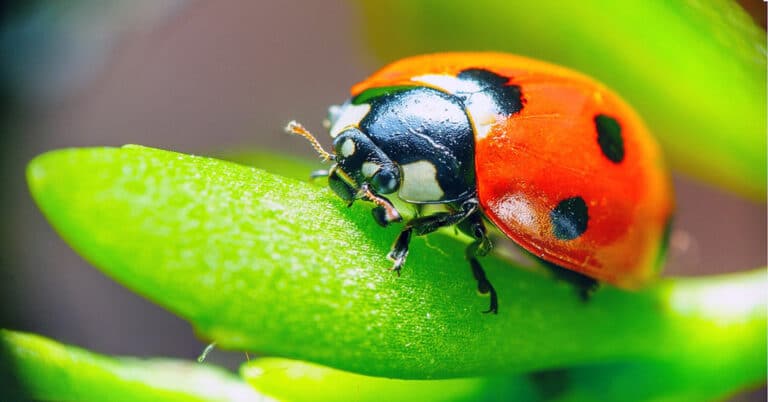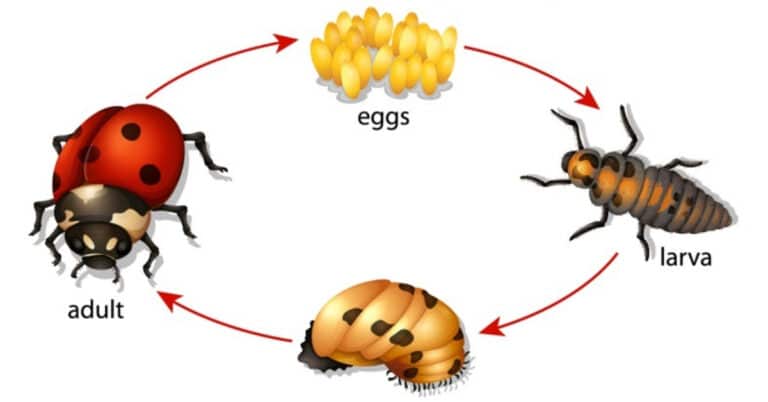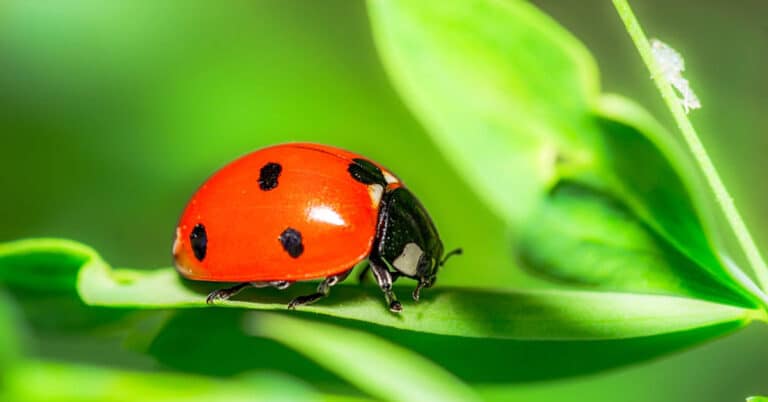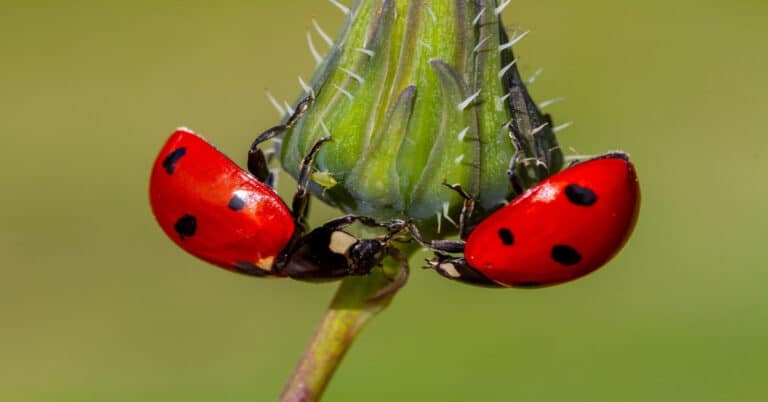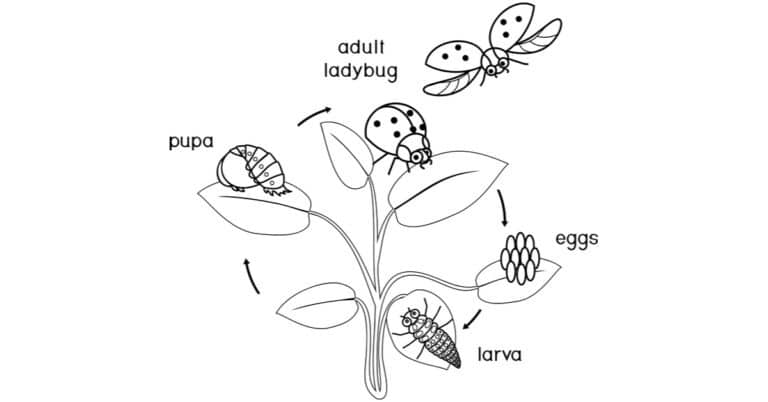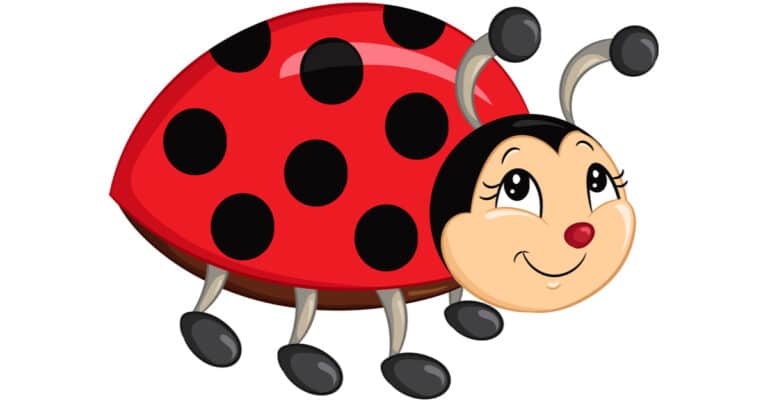Pink Ladybug – Characteristics, Life Cycle & Living Habits
Have you ever seen a pink ladybug? If yes, you will be mesmerized by its beauty and unusual color. Since you came across this article, you must be curious about those unique insects. Pink spotted ladybugs typically have 12 spots and are also scientifically known as Coleomegilla maculata.
Let’s explore those amazing insects and learn more about them.
What Does Pink Ladybug Look Like?
The pink ladybug is typically oblong and flattened, growing to a length of six millimeters on average. Except for the subspecies fuscilabris, which is brilliant orange or red, the species is pink across most of its range.
They are characterized by 6 black marks on each elytron. The thorax has two sizable triangular black spots and a slight shade of red. The seaside ladybug and pink ladybug have the most striking colors. However, those species are only found in coastal areas and have considerably bigger black patterns. Contrary to Coleomegilla maculata, other pink ladybug species merge the apical spot pairs on the wing covers with the pronotum markings.
The larvae are black and look like little alligators. They may reach a length of roughly six millimeters and only have 6 legs. The spindle-shaped eggs are placed erect in clusters close to possible prey.
Why Are Some Ladybugs Pink
Ladybugs come in many different colors. The coloration is determined by several factors. Some affecting factors are local conditions. For example, the weather, temperature, humidity, predators in the area, and food availability can all affect the visual side of those little insects.
Large black patches and a partly pink body are both strong warning indicators of potential predators. Ladybugs have a specific mechanism to protect themselves from potential threats. Their color and spots show the threat that they can be poisonous, toxic, or taste bad.
Therefore, many birds and potential threats do not go near them. The brighter the color is, typically, the more toxic the insect is. Therefore, the red ladybugs are considered to be the most toxic. Even though the pink ladybug has a lower level of toxicity, it can still pose a threat to some of its predators.
Pink Ladybug Life Cycle
Pink ladybugs have the internal fertilization method of reproduction. Female pink ladybugs may use the lowest portions of maize plants for oviposition. They also lay their eggs on different weeds, such as hophornbeam copperleaf, close to cornfields.
In the spring, egg-laying starts and lasts into the summer. Over the course of three months, they have the potential to lay anywhere between 200 and 1,000 eggs.
Egg Stage
Pink ladybug eggs are so tiny and can be similar in appearance to other insect eggs. The majority of ladybug eggs have an oval shape and are orange-yellow in color. Although some species may only lay a few eggs, other species may lay many more. Typically, batches include 10 to 50 eggs.
Part of the eggs are not fertilized, though, and occasionally unfertilized eggs are deposited, which the larvae might eat as their first food when they hatch. This is a typical practice among insects and other animals. For example, several types of frogs feed their tadpoles on unfertilized eggs.
Once the eggs are deposited, the female will not take care of them. She will quietly leave them to perish. However, because ladybugs are cannibalistic, they will make an effort to avoid nesting next to another ladybug’s clutch. The ravenous larvae would undoubtedly devour all of her prized eggs without showing even the slightest remorse. Predators like beetles are a threat to the young as well.
Larvae
For the majority of species, the eggs will develop into larvae within 4 to 10 days. Pink ladybug larvae have 6 legs, a thorax, a head, and an abdomen. The body coloration can vary and is typically dark. The body is also covered with small black markings. Larvae are fluffy and flattened in shape.
All ladybug larvae undergo many molts, during which they lose their exoskeleton and become bigger. They may become vulnerable throughout this process as they struggle to shed their old skins, but they can never gain enough weight to mature into adults without undergoing these alterations. They should reach their last metamorphosis after 3–5 weeks, depending on how much they ate.
Pupa
Although most do resemble a chubby, spherical insect that has curled up in the leaves to rest. The ladybugs’ pupal stays in one place, which often makes them vulnerable to predators. The pink ladybug pupa is either orange or black. Additionally, the pupa also has small black spots.
What Do Pink Ladybugs Eat?
Pink ladybugs can be located in places where their prey is in relatively high quantity. They can be found in a variety of places, such as backyards, wooded areas, and fields, but they are most frequently found in agricultural areas. The most frequently consumed crops are wheat, beans, sorghum, sweet corn, alfalfa, asparagus, potatoes, apples, and tomatoes.
They consume adelgids in addition to aphids, mites, insect eggs, and other tiny larvae. Additionally, it has been reported that they consume up to 50% of their food as pollen. Water, honeydew, and nectar are additional meals.
When they do not have enough food, the pink ladybugs can consume their own kind. Cannibalistic behaviors are typically seen in adult and larvae pink ladybugs. They can consume smaller-size larvae, pupae, or eggs.
Pink ladybugs are considered to be gardeners’ friends. They are known to consume harmful pests and insects. For example, the list includes asparagus beetles, colorado potato beetle, fall webworm, corn earworm, green bugs, aphids, etc.
Pink ladybugs are, therefore, quite similar to other ladybugs, except that up to 50% of their food consists of pollen from flowers like cucumber, dandelion, pepper, and squash.
Cucumber beetles mostly eat the leaves and stems. Whereas both insects, cucumber beetles and pink ladybugs, eat blossom pollen, which boosts pollination rates and doesn’t harm the blooms.
Where Can Pink Ladybug Be Found?
There are three different types of pink ladybugs. All of them are indigenous to North America and are spread throughout the states. Their main habitat is the southern and eastern areas, with relatively high temperatures. Those critters are often found near the Mexican border in Florida. Those three different variations have specific locations and unique characteristics.
Pink Ladybug Species
Coleomegilla Maculata Lengi
The first type of pink ladybug is the Coleomegilla maculata lengi. This particular one holds the majority of individuals among the species of pink ladybugs. This pink ladybug is located in the eastern United States.
Their living environment is pretty limited; therefore, they are not widely spread. The population seems to be smaller in comparison to other species of ladybugs.
In summary, its activity is similar to that of the majority of other ladybug species, and its structure is roughly similar to that of other Coccinellidae ladybugs. For example, their hibernation, mating, and protection traits are similar.
Coleomegilla Maculata Fuscilabris
Coleomegilla maculata fuscilabris is the second species of pink ladybug. Those specific ones are located in Florida. Those ones, in comparison to other pink ladybugs, have a hint of red to their pink hue.
Coleomegilla Maculata Strenua
The third species of pink ladybug is Coleomegilla maculata strenua. They have a vibrant pink color and are found in the United States and in Mexico. They are spread alongside the Mexican border.
Are Pink Ladybugs Poisonous?
First of all, pink ladybugs do not bite unless they feel extremely threatened and scared. They may also bite if they are starving or mistake the person for a soft-bodied insect. Other than that, the pink ladybugs are observed to be attracted to the salts found on human skin.
Those beauties do not pose a threat. Neither have they been linked to the spread of illnesses or allergic reactions. Generally speaking, ladybugs are not toxic. There are no viruses that pink ladybugs carry that may infect people in any way.
Pink Ladybug Symbolism
Pink ladybugs are uncommon. They provide a compelling sight that is symbolic. These bugs’ colors are frequently perceived as showing exceptional friendliness and are distinguished by their pink coloration. These ladybugs have some of the biggest black spots in the whole ladybug kingdom.
Pink ladybugs have a passionate but friendly association with love. It is said that encountering a pink ladybug can make you realize how much you need to appreciate those around you and how much they mean to you.
Those insects are frequently connected with feminine emotions. These entail a certain amount of delicacy or tenderness. When you encounter one, remember your feminine side and embrace it.
Kindness and pink ladybugs are closely related. Compared to yellow ladybugs, these ladybugs give off a stronger impression of being gentler.
Bottom Line
Above in this article, we explored one of the rarest types of ladybugs, pink ladybugs. Those insects consist of three major species: Coleomegilla maculata lengi, Coleomegilla maculata fuscilabris, and Coleomegilla maculata strenua. The pink ladybugs are native to North America and can be found in the United States and Mexico.

Nato is a content writer and researcher with a background in psychology who’s eager to explore the wonders of nature. As a travel enthusiast and animal lover, she hopes to inspire others to discover and cherish the beauty and importance of the natural world.

